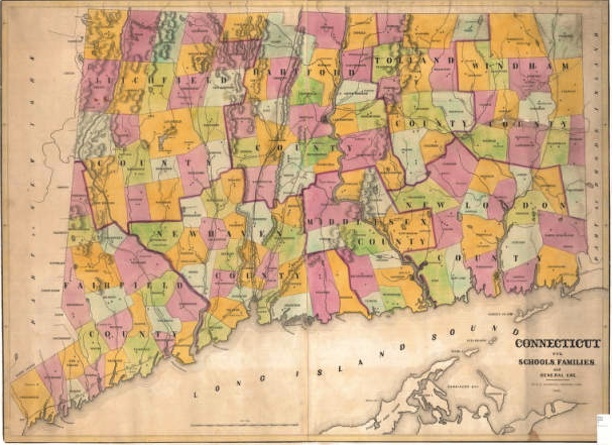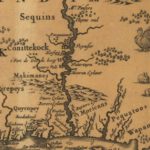Connecticut takes its name from the Mohegan word, “Quinnehtukqut,” referencing the long, winding river flowing through the area utilized by Native Americans for thousands of years. To compete with Dutch traders along the Connecticut River, English Puritans from the Massachusetts Bay colony established the first permanent European settlement in Connecticut in 1633. Connecticut was the fifth state to join the union (1788), and its abundant water power and poor, rocky soil promoted the growth of heavy industry through much of the 19th and early 20th centuries—making it a leading producer of iron, vulcanized rubber, rolled brass, textiles, bicycles, clocks, helicopters, and firearms. Today, Connecticut hosts a diverse array of cultures and lifestyles characterized by its sprawling suburbs, its densely populated urban centers, thriving insurance and small manufacturing industries, the traditional farming communities found in the Litchfield Hills and its northeastern “quiet corner,” and its bustling shoreline vacation spots.
Featured
A timeline displaying the major events leading to Connecticut statehood, including its settlement by the Dutch, the origins of Hartford, Wethersfield, and Windsor, the founding of the Connecticut, New Haven, and Saybrook colonies, and Connecticut's acquisition of a formal charter from England. …[more]
Learn More
58529
FE8G6REP
1
apsa
50
default
41905
https://connecticuthistory.org/wp-content/plugins/zotpress/
%7B%22status%22%3A%22success%22%2C%22updateneeded%22%3Afalse%2C%22instance%22%3Afalse%2C%22meta%22%3A%7B%22request_last%22%3A0%2C%22request_next%22%3A0%2C%22used_cache%22%3Atrue%7D%2C%22data%22%3A%5B%7B%22key%22%3A%22UBX5SCJD%22%2C%22library%22%3A%7B%22id%22%3A58529%7D%2C%22meta%22%3A%7B%22lastModifiedByUser%22%3A%7B%22id%22%3A14399323%2C%22username%22%3A%22kquotap%22%2C%22name%22%3A%22%22%2C%22links%22%3A%7B%22alternate%22%3A%7B%22href%22%3A%22https%3A%5C%2F%5C%2Fwww.zotero.org%5C%2Fkquotap%22%2C%22type%22%3A%22text%5C%2Fhtml%22%7D%7D%7D%2C%22numChildren%22%3A1%7D%2C%22bib%22%3A%22%3Cdiv%20class%3D%5C%22csl-bib-body%5C%22%20style%3D%5C%22line-height%3A%201.35%3B%20padding-left%3A%201em%3B%20text-indent%3A-1em%3B%5C%22%3E%5Cn%20%20%3Cdiv%20class%3D%5C%22csl-entry%5C%22%3E%26%23x201C%3BConnecticut%20State%20Library.%26%23x201D%3B%20%3Ca%20class%3D%27zp-ItemURL%27%20href%3D%27http%3A%5C%2F%5C%2Fwww.ctstatelibrary.org%5C%2F%27%3Ehttp%3A%5C%2F%5C%2Fwww.ctstatelibrary.org%5C%2F%3C%5C%2Fa%3E%20%28October%202%2C%202013%29.%3C%5C%2Fdiv%3E%5Cn%3C%5C%2Fdiv%3E%22%2C%22data%22%3A%7B%22itemType%22%3A%22webpage%22%2C%22title%22%3A%22Connecticut%20State%20Library%22%2C%22creators%22%3A%5B%5D%2C%22abstractNote%22%3A%22%22%2C%22date%22%3A%22%22%2C%22url%22%3A%22http%3A%5C%2F%5C%2Fwww.ctstatelibrary.org%5C%2F%22%2C%22language%22%3A%22%22%2C%22collections%22%3A%5B%22FE8G6REP%22%2C%225F5984C9%22%2C%22S2HPVKQX%22%2C%22PQBMFBQJ%22%2C%22244H5NUG%22%2C%22XD2PEQFS%22%2C%22BG4RZD2W%22%2C%227D3TARZH%22%2C%22C2XTNRE6%22%2C%22DI77DVM8%22%2C%22S3KIVW4U%22%2C%22KW7DQ52D%22%2C%22ETECPRTB%22%2C%22769GIQVG%22%2C%223AVQZV8X%22%2C%22QAJ2KUDK%22%5D%2C%22dateModified%22%3A%222024-08-22T16%3A03%3A43Z%22%7D%7D%2C%7B%22key%22%3A%2232HNRDDR%22%2C%22library%22%3A%7B%22id%22%3A58529%7D%2C%22meta%22%3A%7B%22lastModifiedByUser%22%3A%7B%22id%22%3A14399323%2C%22username%22%3A%22kquotap%22%2C%22name%22%3A%22%22%2C%22links%22%3A%7B%22alternate%22%3A%7B%22href%22%3A%22https%3A%5C%2F%5C%2Fwww.zotero.org%5C%2Fkquotap%22%2C%22type%22%3A%22text%5C%2Fhtml%22%7D%7D%7D%2C%22parsedDate%22%3A%222016%22%2C%22numChildren%22%3A1%7D%2C%22bib%22%3A%22%3Cdiv%20class%3D%5C%22csl-bib-body%5C%22%20style%3D%5C%22line-height%3A%201.35%3B%20padding-left%3A%201em%3B%20text-indent%3A-1em%3B%5C%22%3E%5Cn%20%20%3Cdiv%20class%3D%5C%22csl-entry%5C%22%3E%26%23x201C%3BConnecticut%20State%20Register%20%26amp%3B%20Manual.%26%23x201D%3B%202016.%20%3Ci%3EConnecticut%20Secretary%20of%20State%3C%5C%2Fi%3E.%20%3Ca%20class%3D%27zp-ItemURL%27%20href%3D%27https%3A%5C%2F%5C%2Fportal.ct.gov%5C%2FSOTS%5C%2FRegister-Manual%5C%2FRegister-Manual%5C%2FConnecticut-State-Register--Manual%27%3Ehttps%3A%5C%2F%5C%2Fportal.ct.gov%5C%2FSOTS%5C%2FRegister-Manual%5C%2FRegister-Manual%5C%2FConnecticut-State-Register--Manual%3C%5C%2Fa%3E%20%28June%2027%2C%202012%29.%3C%5C%2Fdiv%3E%5Cn%3C%5C%2Fdiv%3E%22%2C%22data%22%3A%7B%22itemType%22%3A%22webpage%22%2C%22title%22%3A%22Connecticut%20State%20Register%20%26%20Manual%22%2C%22creators%22%3A%5B%5D%2C%22abstractNote%22%3A%22%22%2C%22date%22%3A%222016%22%2C%22url%22%3A%22https%3A%5C%2F%5C%2Fportal.ct.gov%5C%2FSOTS%5C%2FRegister-Manual%5C%2FRegister-Manual%5C%2FConnecticut-State-Register--Manual%22%2C%22language%22%3A%22%22%2C%22collections%22%3A%5B%2225SNRXJR%22%2C%22CTGEE4UN%22%2C%22FE8G6REP%22%2C%229VCQANH3%22%5D%2C%22dateModified%22%3A%222023-09-12T13%3A15%3A43Z%22%7D%7D%2C%7B%22key%22%3A%22TQTC9SJA%22%2C%22library%22%3A%7B%22id%22%3A58529%7D%2C%22meta%22%3A%7B%22lastModifiedByUser%22%3A%7B%22id%22%3A14399323%2C%22username%22%3A%22kquotap%22%2C%22name%22%3A%22%22%2C%22links%22%3A%7B%22alternate%22%3A%7B%22href%22%3A%22https%3A%5C%2F%5C%2Fwww.zotero.org%5C%2Fkquotap%22%2C%22type%22%3A%22text%5C%2Fhtml%22%7D%7D%7D%2C%22parsedDate%22%3A%222017%22%2C%22numChildren%22%3A1%7D%2C%22bib%22%3A%22%3Cdiv%20class%3D%5C%22csl-bib-body%5C%22%20style%3D%5C%22line-height%3A%201.35%3B%20padding-left%3A%201em%3B%20text-indent%3A-1em%3B%5C%22%3E%5Cn%20%20%3Cdiv%20class%3D%5C%22csl-entry%5C%22%3E%26%23x201C%3BState%20Register%20of%20Historic%20Places.%26%23x201D%3B%202017.%20%3Ci%3EConnecticut%20Department%20of%20Economic%20%26amp%3B%20Community%20Development%3C%5C%2Fi%3E.%20%3Ca%20class%3D%27zp-ItemURL%27%20href%3D%27https%3A%5C%2F%5C%2Fportal.ct.gov%5C%2FDECD%5C%2FContent%5C%2FHistoric-Preservation%5C%2F01_Programs_Services%5C%2FHistoric-Designations%5C%2FState-Registry-of-Historic-Places%27%3Ehttps%3A%5C%2F%5C%2Fportal.ct.gov%5C%2FDECD%5C%2FContent%5C%2FHistoric-Preservation%5C%2F01_Programs_Services%5C%2FHistoric-Designations%5C%2FState-Registry-of-Historic-Places%3C%5C%2Fa%3E%20%28September%2012%2C%202013%29.%3C%5C%2Fdiv%3E%5Cn%3C%5C%2Fdiv%3E%22%2C%22data%22%3A%7B%22itemType%22%3A%22webpage%22%2C%22title%22%3A%22State%20Register%20of%20Historic%20Places%22%2C%22creators%22%3A%5B%5D%2C%22abstractNote%22%3A%22%22%2C%22date%22%3A%222017%22%2C%22url%22%3A%22https%3A%5C%2F%5C%2Fportal.ct.gov%5C%2FDECD%5C%2FContent%5C%2FHistoric-Preservation%5C%2F01_Programs_Services%5C%2FHistoric-Designations%5C%2FState-Registry-of-Historic-Places%22%2C%22language%22%3A%22%22%2C%22collections%22%3A%5B%224SN4JGBX%22%2C%2269MW5DB5%22%2C%223Z6SBSH7%22%2C%22FE8G6REP%22%2C%22N5ZXWHQN%22%2C%22VZETEEIV%22%2C%229VCQANH3%22%5D%2C%22dateModified%22%3A%222023-09-11T19%3A19%3A53Z%22%7D%7D%2C%7B%22key%22%3A%22SNPD29MW%22%2C%22library%22%3A%7B%22id%22%3A58529%7D%2C%22meta%22%3A%7B%22lastModifiedByUser%22%3A%7B%22id%22%3A14399323%2C%22username%22%3A%22kquotap%22%2C%22name%22%3A%22%22%2C%22links%22%3A%7B%22alternate%22%3A%7B%22href%22%3A%22https%3A%5C%2F%5C%2Fwww.zotero.org%5C%2Fkquotap%22%2C%22type%22%3A%22text%5C%2Fhtml%22%7D%7D%7D%2C%22parsedDate%22%3A%222016%22%2C%22numChildren%22%3A0%7D%2C%22bib%22%3A%22%3Cdiv%20class%3D%5C%22csl-bib-body%5C%22%20style%3D%5C%22line-height%3A%201.35%3B%20padding-left%3A%201em%3B%20text-indent%3A-1em%3B%5C%22%3E%5Cn%20%20%3Cdiv%20class%3D%5C%22csl-entry%5C%22%3E%26%23x201C%3BConnecticut%20State%20Museum%20of%20Natural%20History.%26%23x201D%3B%202016.%20%3Ca%20class%3D%27zp-ItemURL%27%20href%3D%27https%3A%5C%2F%5C%2Fmnh.uconn.edu%5C%2Findex.html%27%3Ehttps%3A%5C%2F%5C%2Fmnh.uconn.edu%5C%2Findex.html%3C%5C%2Fa%3E.%3C%5C%2Fdiv%3E%5Cn%3C%5C%2Fdiv%3E%22%2C%22data%22%3A%7B%22itemType%22%3A%22webpage%22%2C%22title%22%3A%22Connecticut%20State%20Museum%20of%20Natural%20History%22%2C%22creators%22%3A%5B%5D%2C%22abstractNote%22%3A%22%22%2C%22date%22%3A%222016%22%2C%22url%22%3A%22https%3A%5C%2F%5C%2Fmnh.uconn.edu%5C%2Findex.html%22%2C%22language%22%3A%22%22%2C%22collections%22%3A%5B%22J3HKXUPP%22%2C%22Q3MENUEB%22%2C%22GXT9G7JA%22%2C%22U4XWMHTM%22%2C%22NFPZ5T2J%22%2C%22PSTBQPHT%22%2C%22FE8G6REP%22%2C%223Z3DZ5PI%22%2C%22EI2UGM77%22%2C%22XD2PEQFS%22%2C%223RXXGBCJ%22%5D%2C%22dateModified%22%3A%222020-08-13T11%3A13%3A55Z%22%7D%7D%2C%7B%22key%22%3A%22MRI32WU5%22%2C%22library%22%3A%7B%22id%22%3A58529%7D%2C%22meta%22%3A%7B%22lastModifiedByUser%22%3A%7B%22id%22%3A16014488%2C%22username%22%3A%22mkemezisCTH%22%2C%22name%22%3A%22%22%2C%22links%22%3A%7B%22alternate%22%3A%7B%22href%22%3A%22https%3A%5C%2F%5C%2Fwww.zotero.org%5C%2Fmkemeziscth%22%2C%22type%22%3A%22text%5C%2Fhtml%22%7D%7D%7D%2C%22parsedDate%22%3A%222016%22%2C%22numChildren%22%3A0%7D%2C%22bib%22%3A%22%3Cdiv%20class%3D%5C%22csl-bib-body%5C%22%20style%3D%5C%22line-height%3A%201.35%3B%20padding-left%3A%201em%3B%20text-indent%3A-1em%3B%5C%22%3E%5Cn%20%20%3Cdiv%20class%3D%5C%22csl-entry%5C%22%3E%26%23x201C%3BThe%20Collier%20Collection%20of%20Connecticut%20History%20Books.%26%23x201D%3B%202016.%20%3Ci%3EFairfield%20Museum%20and%20History%20Center%3C%5C%2Fi%3E.%20%3Ca%20class%3D%27zp-ItemURL%27%20href%3D%27http%3A%5C%2F%5C%2Fwww.fairfieldhistory.org%5C%2Flibrary-collections%5C%2Fcollections%5C%2F%27%3Ehttp%3A%5C%2F%5C%2Fwww.fairfieldhistory.org%5C%2Flibrary-collections%5C%2Fcollections%5C%2F%3C%5C%2Fa%3E.%3C%5C%2Fdiv%3E%5Cn%3C%5C%2Fdiv%3E%22%2C%22data%22%3A%7B%22itemType%22%3A%22webpage%22%2C%22title%22%3A%22The%20Collier%20Collection%20of%20Connecticut%20History%20Books%22%2C%22creators%22%3A%5B%5D%2C%22abstractNote%22%3A%22%22%2C%22date%22%3A%222016%22%2C%22url%22%3A%22http%3A%5C%2F%5C%2Fwww.fairfieldhistory.org%5C%2Flibrary-collections%5C%2Fcollections%5C%2F%22%2C%22language%22%3A%22%22%2C%22collections%22%3A%5B%22FE8G6REP%22%2C%22HPCD5VH7%22%5D%2C%22dateModified%22%3A%222016-04-27T15%3A25%3A37Z%22%7D%7D%2C%7B%22key%22%3A%22S6BNF6QT%22%2C%22library%22%3A%7B%22id%22%3A58529%7D%2C%22meta%22%3A%7B%22lastModifiedByUser%22%3A%7B%22id%22%3A14399323%2C%22username%22%3A%22kquotap%22%2C%22name%22%3A%22%22%2C%22links%22%3A%7B%22alternate%22%3A%7B%22href%22%3A%22https%3A%5C%2F%5C%2Fwww.zotero.org%5C%2Fkquotap%22%2C%22type%22%3A%22text%5C%2Fhtml%22%7D%7D%7D%2C%22creatorSummary%22%3A%22Mangan%22%2C%22parsedDate%22%3A%222015%22%2C%22numChildren%22%3A0%7D%2C%22bib%22%3A%22%3Cdiv%20class%3D%5C%22csl-bib-body%5C%22%20style%3D%5C%22line-height%3A%201.35%3B%20padding-left%3A%201em%3B%20text-indent%3A-1em%3B%5C%22%3E%5Cn%20%20%3Cdiv%20class%3D%5C%22csl-entry%5C%22%3EMangan%2C%20Gregg.%202015.%20%3Ci%3EOn%20This%20Day%20in%20Connecticut%20History%3C%5C%2Fi%3E.%20Charleston%2C%20SC%3A%20History%20Press.%3C%5C%2Fdiv%3E%5Cn%3C%5C%2Fdiv%3E%22%2C%22data%22%3A%7B%22itemType%22%3A%22book%22%2C%22title%22%3A%22On%20This%20Day%20in%20Connecticut%20History%22%2C%22creators%22%3A%5B%7B%22creatorType%22%3A%22author%22%2C%22firstName%22%3A%22Gregg%22%2C%22lastName%22%3A%22Mangan%22%7D%5D%2C%22abstractNote%22%3A%22%22%2C%22date%22%3A%222015%22%2C%22language%22%3A%22%22%2C%22ISBN%22%3A%22%22%2C%22url%22%3A%22%22%2C%22collections%22%3A%5B%228V92VC4J%22%2C%227CA8WUFM%22%2C%22WRTM69ZP%22%2C%22C2P8MPKG%22%2C%22CIFMBVH5%22%2C%22FE8G6REP%22%2C%22HPCD5VH7%22%2C%22P4XURUEE%22%2C%227NVEQAEE%22%2C%22CW5JT8XF%22%2C%22M6HJESFG%22%2C%22Q25MJ89F%22%2C%22UXST2JXV%22%2C%22BJ9UEFGB%22%2C%22MS4PGEIF%22%2C%229S5CIPXU%22%5D%2C%22dateModified%22%3A%222016-04-14T13%3A20%3A41Z%22%7D%7D%2C%7B%22key%22%3A%22V5AV26UI%22%2C%22library%22%3A%7B%22id%22%3A58529%7D%2C%22meta%22%3A%7B%22lastModifiedByUser%22%3A%7B%22id%22%3A14399323%2C%22username%22%3A%22kquotap%22%2C%22name%22%3A%22%22%2C%22links%22%3A%7B%22alternate%22%3A%7B%22href%22%3A%22https%3A%5C%2F%5C%2Fwww.zotero.org%5C%2Fkquotap%22%2C%22type%22%3A%22text%5C%2Fhtml%22%7D%7D%7D%2C%22creatorSummary%22%3A%22Faude%22%2C%22parsedDate%22%3A%222010%22%2C%22numChildren%22%3A0%7D%2C%22bib%22%3A%22%3Cdiv%20class%3D%5C%22csl-bib-body%5C%22%20style%3D%5C%22line-height%3A%201.35%3B%20padding-left%3A%201em%3B%20text-indent%3A-1em%3B%5C%22%3E%5Cn%20%20%3Cdiv%20class%3D%5C%22csl-entry%5C%22%3EFaude%2C%20Wilson%20H.%202010.%20%3Ci%3EHidden%20History%20of%20Connecticut%3C%5C%2Fi%3E.%20Charleston%2C%20SC%3A%20History%20Press.%3C%5C%2Fdiv%3E%5Cn%3C%5C%2Fdiv%3E%22%2C%22data%22%3A%7B%22itemType%22%3A%22book%22%2C%22title%22%3A%22Hidden%20History%20of%20Connecticut%22%2C%22creators%22%3A%5B%7B%22creatorType%22%3A%22author%22%2C%22firstName%22%3A%22Wilson%20H.%22%2C%22lastName%22%3A%22Faude%22%7D%5D%2C%22abstractNote%22%3A%22%22%2C%22date%22%3A%222010%22%2C%22language%22%3A%22English%22%2C%22ISBN%22%3A%22978-1-59629-319-9%201-59629-319-5%22%2C%22url%22%3A%22%22%2C%22collections%22%3A%5B%228V92VC4J%22%2C%227CA8WUFM%22%2C%22IDIGH2FG%22%2C%22QHZSBAJE%22%2C%22FE8G6REP%22%2C%22HPCD5VH7%22%5D%2C%22dateModified%22%3A%222013-05-01T18%3A23%3A16Z%22%7D%7D%2C%7B%22key%22%3A%22TBU7ZQMG%22%2C%22library%22%3A%7B%22id%22%3A58529%7D%2C%22meta%22%3A%7B%22lastModifiedByUser%22%3A%7B%22id%22%3A16014488%2C%22username%22%3A%22mkemezisCTH%22%2C%22name%22%3A%22%22%2C%22links%22%3A%7B%22alternate%22%3A%7B%22href%22%3A%22https%3A%5C%2F%5C%2Fwww.zotero.org%5C%2Fmkemeziscth%22%2C%22type%22%3A%22text%5C%2Fhtml%22%7D%7D%7D%2C%22creatorSummary%22%3A%22Hughes%20and%20Allen%22%2C%22parsedDate%22%3A%221976%22%2C%22numChildren%22%3A0%7D%2C%22bib%22%3A%22%3Cdiv%20class%3D%5C%22csl-bib-body%5C%22%20style%3D%5C%22line-height%3A%201.35%3B%20padding-left%3A%201em%3B%20text-indent%3A-1em%3B%5C%22%3E%5Cn%20%20%3Cdiv%20class%3D%5C%22csl-entry%5C%22%3EHughes%2C%20Arthur%20H.%2C%20and%20Morse%20S.%20Allen.%201976.%20%3Ci%3EConnecticut%20Place%20Names%3C%5C%2Fi%3E.%20Hartford%2C%20CT%3A%20Connecticut%20Historical%20Society.%3C%5C%2Fdiv%3E%5Cn%3C%5C%2Fdiv%3E%22%2C%22data%22%3A%7B%22itemType%22%3A%22book%22%2C%22title%22%3A%22Connecticut%20Place%20Names%22%2C%22creators%22%3A%5B%7B%22creatorType%22%3A%22author%22%2C%22firstName%22%3A%22Arthur%20H.%22%2C%22lastName%22%3A%22Hughes%22%7D%2C%7B%22creatorType%22%3A%22author%22%2C%22firstName%22%3A%22Morse%20S.%22%2C%22lastName%22%3A%22Allen%22%7D%5D%2C%22abstractNote%22%3A%22%22%2C%22date%22%3A%221976%22%2C%22language%22%3A%22English%22%2C%22ISBN%22%3A%22%22%2C%22url%22%3A%22%22%2C%22collections%22%3A%5B%22FE8G6REP%22%2C%22HPCD5VH7%22%2C%225V323H84%22%5D%2C%22dateModified%22%3A%222013-02-16T04%3A18%3A40Z%22%7D%7D%2C%7B%22key%22%3A%22J59T75VR%22%2C%22library%22%3A%7B%22id%22%3A58529%7D%2C%22meta%22%3A%7B%22lastModifiedByUser%22%3A%7B%22id%22%3A14399323%2C%22username%22%3A%22kquotap%22%2C%22name%22%3A%22%22%2C%22links%22%3A%7B%22alternate%22%3A%7B%22href%22%3A%22https%3A%5C%2F%5C%2Fwww.zotero.org%5C%2Fkquotap%22%2C%22type%22%3A%22text%5C%2Fhtml%22%7D%7D%7D%2C%22creatorSummary%22%3A%22Fraser%20and%20Connecticut%20Historical%20Commission%22%2C%22parsedDate%22%3A%221988%22%2C%22numChildren%22%3A0%7D%2C%22bib%22%3A%22%3Cdiv%20class%3D%5C%22csl-bib-body%5C%22%20style%3D%5C%22line-height%3A%201.35%3B%20padding-left%3A%201em%3B%20text-indent%3A-1em%3B%5C%22%3E%5Cn%20%20%3Cdiv%20class%3D%5C%22csl-entry%5C%22%3EFraser%2C%20Bruce%2C%20and%20Connecticut%20Historical%20Commission.%201988.%20%3Ci%3EThe%20Land%20of%20Steady%20Habits%3A%20A%20Brief%20History%20of%20Connecticut%3C%5C%2Fi%3E.%20Hartford%2C%20CT%3A%20Connecticut%20Historical%20Commission.%3C%5C%2Fdiv%3E%5Cn%3C%5C%2Fdiv%3E%22%2C%22data%22%3A%7B%22itemType%22%3A%22book%22%2C%22title%22%3A%22The%20Land%20of%20Steady%20Habits%3A%20A%20Brief%20History%20of%20Connecticut%22%2C%22creators%22%3A%5B%7B%22creatorType%22%3A%22author%22%2C%22firstName%22%3A%22Bruce%22%2C%22lastName%22%3A%22Fraser%22%7D%2C%7B%22creatorType%22%3A%22author%22%2C%22name%22%3A%22Connecticut%20Historical%20Commission%22%7D%5D%2C%22abstractNote%22%3A%22%22%2C%22date%22%3A%221988%22%2C%22language%22%3A%22English%22%2C%22ISBN%22%3A%220-918676-22-3%20978-0-918676-22-1%22%2C%22url%22%3A%22%22%2C%22collections%22%3A%5B%22CTGEE4UN%22%2C%22Q46WNT7U%22%2C%22FE8G6REP%22%2C%22HPCD5VH7%22%2C%22V88W4E7D%22%5D%2C%22dateModified%22%3A%222012-11-12T21%3A18%3A08Z%22%7D%7D%5D%7D
“Connecticut State Library.”
http://www.ctstatelibrary.org/ (October 2, 2013).
“Connecticut State Register & Manual.” 2016.
Connecticut Secretary of State.
https://portal.ct.gov/SOTS/Register-Manual/Register-Manual/Connecticut-State-Register--Manual (June 27, 2012).
“Connecticut State Museum of Natural History.” 2016.
https://mnh.uconn.edu/index.html.
“The Collier Collection of Connecticut History Books.” 2016.
Fairfield Museum and History Center.
http://www.fairfieldhistory.org/library-collections/collections/.
Mangan, Gregg. 2015. On This Day in Connecticut History. Charleston, SC: History Press.
Faude, Wilson H. 2010. Hidden History of Connecticut. Charleston, SC: History Press.
Hughes, Arthur H., and Morse S. Allen. 1976. Connecticut Place Names. Hartford, CT: Connecticut Historical Society.
Fraser, Bruce, and Connecticut Historical Commission. 1988. The Land of Steady Habits: A Brief History of Connecticut. Hartford, CT: Connecticut Historical Commission.






